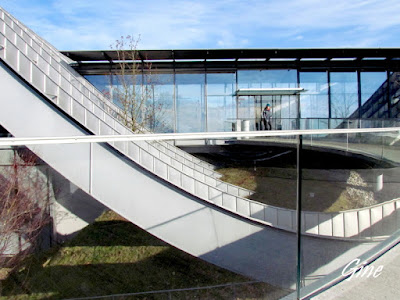 |
| Architect: Renzo Piano |
The Paul Klee Centre in Bern, wants "more than a museum of fine arts is a place that calls to address happy art and culture. "
And we must say he succeeded. If architecture is spectacular, it gives, upon arrival, a sense of beauty. Three "hills" are home to some 4,000 works of Paul Klee and important archives, the museum must develop through innovative presentations. Salles exhibition, concert, seminars, a section-entertainment for children and adults, all gathered ways to "do enjoy art and culture today pulse that represents the creative potential of Paul Klee.
The current exhibition "Paul Klee, Franz Marc, Dialogue in Pictures" highlights the friendship between the two painters who met in 1912 during preparations for the second exhibition of the Blaue Reiter in Munich. Despite the sometimes heated exchanges, their friendship will be broken only by the death of Franz Marc, at Verdun in 1916.
 |
| Franz Marc, Gazellen, 1913/1914 |
 |
| Paul Klee Der Niesen, 1915 |
(Paul Klee, Journal III, April 1914) This exhibition
especially interested me for its inclusion in the artistic movement of the time. AvecKandinsky, Macke, Jawlenski, Münter, the Blaue Reiter, Klee and Marc have an artistic policy, despite some differences, especially political. The meeting with Delaunay
Klee leads to a new approach to color and abstraction, while Marc took over the ideas in "representations of abstract color and prismatic surfaces.
 |
| Franz Marc Gelber Löwe blaue Füchse, blaue Pferd |
(Franz Marc, The Hundred aphorisms. The second view, 1915)
Source: Handbook of exposure, Zentrum Paul Klee http://www.zpk . org /
Zentrum Paul Klee, Bern, Guide


0 comments:
Post a Comment